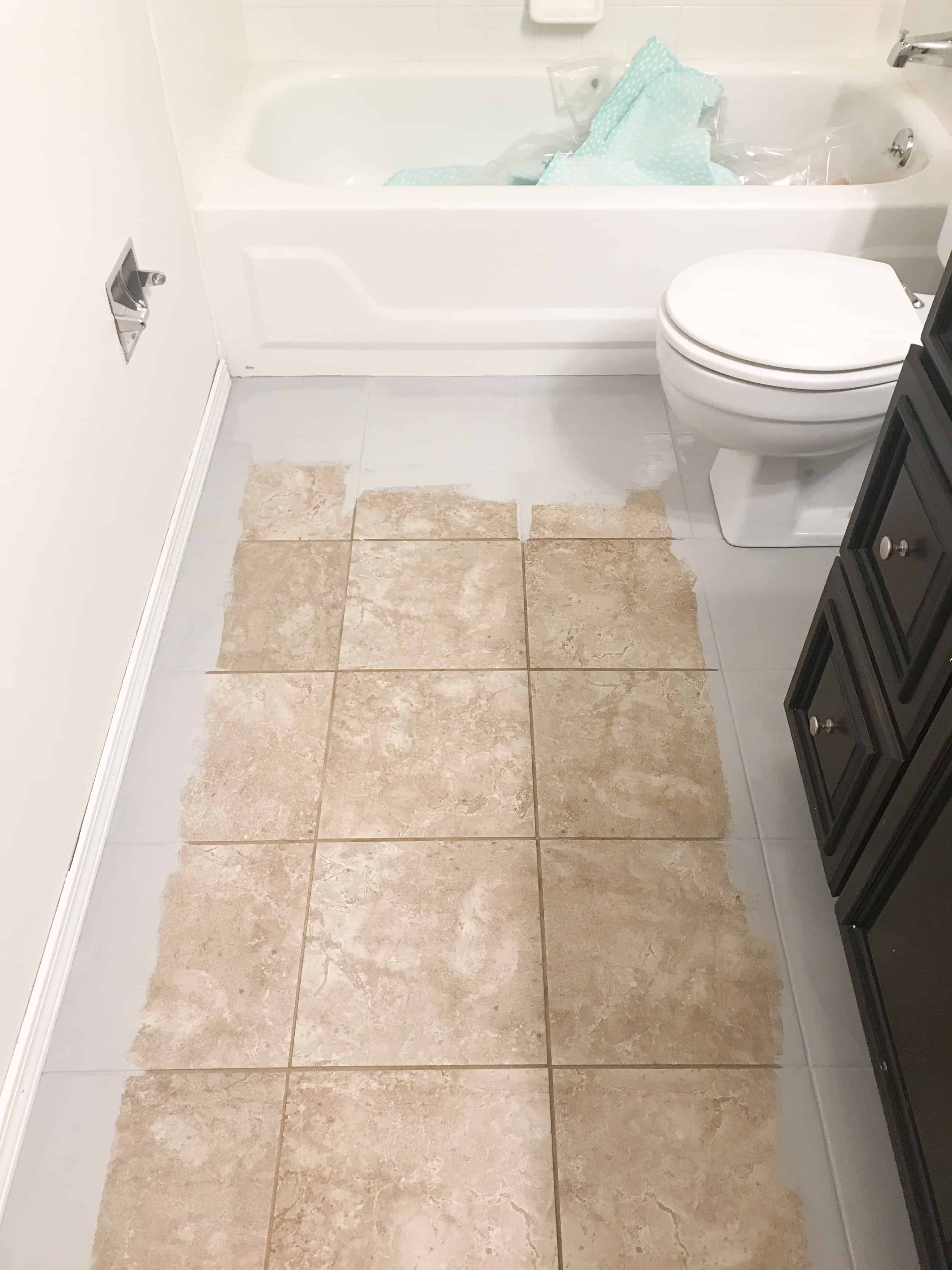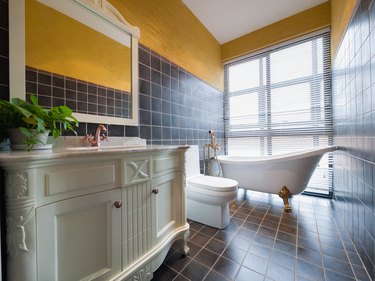Ever wish you could swap out the dated brown tile in your kitchen for something more modern and vibrant? Or maybe you’re simply tired of the bland white tile in your bathroom? You’re not alone! Many homeowners find themselves yearning for a new look without the costly and disruptive process of replacing their entire tile floor. But before you jump into a DIY project, let’s dive into the world of tile floor color transformation and explore the possibilities available to you.

Image: phenergandm.com
Changing the color of your tile floor without ripping it up might seem like a dream, but it’s not as far-fetched as you might think. Thanks to advancements in paint and staining techniques, transforming your tired tiles into a stylish focal point in your home is more achievable than ever. This guide will explore the various methods you can use to give your existing tile floor a fresh and modern look that perfectly matches your style and budget.
Methods for Changing Tile Floor Color
1. Tile Paint
Tile paint is a popular choice for homeowners seeking a quick and relatively inexpensive way to refresh their existing tile floors. This paint is specifically formulated to adhere to ceramic and porcelain tiles, offering a durable and water-resistant finish. It’s available in a plethora of colors, giving you endless options to personalize your space.
Here’s a rundown of the process:
- Prepare the Surface: Thoroughly clean your tiles to remove any dirt, grease, or grime. This ensures proper paint adhesion.
- Prime the Tiles: Applying a tile primer creates a smooth, even surface for the paint to adhere to, contributing to a better overall finish.
- Apply the Tile Paint: Use a high-quality brush or roller for even application. Several thin coats might be necessary for optimal coverage.
- Seal the Paint: After the paint has cured completely, apply a sealant to protect it from wear, tear, and moisture, increasing its lifespan.
Pros:
- Cost-effective
- Wide array of colors available
- Relatively easy to apply
Cons:
- Might require multiple layers for full coverage
- Not as durable as tile staining
- May not be suitable for high-traffic areas
2. Tile Stain
Tile stain penetrates the surface of your tiles, permanently changing their color. This technique is ideal for achieving a more natural and authentic look, particularly for creating aged or distressed effects. Because the stain permeates the tile, it’s much more durable than paint, making it a great choice for high-traffic areas.
The process for tile staining involves the following steps:
- Prepare the Surface: Clean the tiles thoroughly to ensure the stain adheres properly.
- Apply the Stain: Use a brush or sponge for an even application. Allow the stain to penetrate the tiles completely.
- Seal the Stain: Apply a sealant to protect the stain from wear and tear, enhancing its longevity.
Pros:
- Highly durable finish
- Natural and authentic look
- Suitable for high-traffic areas
Cons:
- More difficult to apply compared to paint
- Limited color options available
- Potentially more expensive than paint

Image: www.hunker.com
3. Tile Decals
If you’re looking for a quick and easy way to add a splash of color and personality to your tiles, tile decals are a fantastic option. These adhesive decals are available in endless designs, textures, and colors, making them a versatile choice for customizing your tile floors. They can add pops of color, create intricate patterns, or even mimic the look of natural stone.
Here are the basic steps involved in using tile decals:
- Prepare the Surface: Clean your tiles thoroughly and ensure they are dry before applying the decals.
- Measure and Cut: Measure and cut the decals to fit your tiles perfectly.
- Apply: Slowly peel back the backing paper and smooth the decal onto the tile, ensuring no air bubbles are trapped underneath.
Pros:
- Easy and quick application
- Wide variety of colors, designs, and textures available
- Removable and replaceable
Cons:
- Not as durable as paint or stain
- May not be suitable for high-traffic areas
- Can fade or peel over time
4. Epoxy Coating
Epoxy coating is a two-part resin system that provides a durable, water-resistant, and decorative finish for tiles. It’s often used for commercial spaces, but it can be a good option for homeowners seeking a highly durable and moisture-resistant finish for their tile floors. While it does offer color, epoxy coating is primarily designed to create a uniform, protective layer rather than achieving a specific color scheme.
The epoxy application process involves the following steps:
- Prepare the Surface: Thoroughly clean and prepare your tiles, ensuring they are free of dirt, dust, and grease.
- Mix the Epoxy: Carefully mix the epoxy resin and hardener according to the manufacturer’s instructions.
- Apply the Coating: Use a roller or brush to apply the epoxy evenly to the tiles, avoiding bubbles and drips.
- Cure the Epoxy: Allow the epoxy to cure completely as per the manufacturer’s instructions.
Pros:
- Extremely durable and long-lasting
- Moisture-resistant and easy to clean
- Offers a smooth, uniform finish
Cons:
- Can be challenging to apply properly
- Potentially more expensive than other methods
- Limited color options compared to paint or stain
Choosing the Right Method for You
The best method for changing the color of your tile floor depends on your specific needs, budget, and desired outcome. Consider these factors when making your decision:
- Budget: Tile paint is generally the most affordable option, followed by tile decals. Epoxy coating and tile staining tend to be more expensive.
- Desired Look: Tile paint offers the widest range of color options, making it ideal for achieving a specific shade. Tile stains create a more natural and authentic look. Decals provide endless design and texture options. Epoxy coating offers a uniform and protective layer, with limited color variations.
- Traffic Level: When dealing with high-traffic areas, tile stain or epoxy coating offers greater durability.
- DIY Skills: Tile painting is a relatively easy DIY project. Tile staining and epoxy coating require a bit more experience and skill. Decals are the most straightforward DIY option.
Tips for Success
Whether you’re painting, staining, or applying decals to your tile floor, a few tips will ensure you achieve the best results:
- Thorough Preparation: Properly cleaning and preparing the surface is crucial for adhesion and long-lasting results.
- High-Quality Products: Investing in quality paint, stain, or epoxy will lead to better adhesion, color retention, and durability.
- Follow Instructions: Adhering to the manufacturer’s instructions for application, curing, and sealing will maximize both performance and longevity.
- Practice: If you’re unsure about the process, practice on a spare tile before tackling your entire floor.
- Patience: Allow ample time for the product to cure completely. Rushing the process can result in lower quality results.
Can I Change The Color Of My Tile Floor
Conclusion
Transforming the color of your tile floor doesn’t have to be a daunting or expensive task. With the right approach and knowledge, you can create a fresh and stylish look that perfectly complements your home’s design. Whether you opt for paint, stain, decals, or epoxy coating, choosing the right method and diligently following the steps will ensure a successful transformation. So, unleash your creativity and get ready to give your tile floors a whole new lease on life!

:max_bytes(150000):strip_icc()/OrangeGloEverydayHardwoodFloorCleaner22oz-5a95a4dd04d1cf0037cbd59c.jpeg?w=740&resize=740,414&ssl=1)




